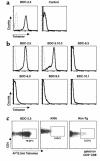Susceptible MHC alleles, not background genes, select an autoimmune T cell reactivity
- PMID: 12975475
- PMCID: PMC193666
- DOI: 10.1172/JCI18337
Susceptible MHC alleles, not background genes, select an autoimmune T cell reactivity
Abstract
To detect and characterize autoreactive T cells in diabetes-prone NOD mice, we have developed a multimeric MHC reagent with high affinity for the BDC-2.5 T cell receptor, which is reactive against a pancreatic autoantigen. A distinct population of T cells is detected in NOD mice that recognizes the same MHC/peptide target. These T cells are positively selected in the thymus at a surprisingly high frequency and exported to the periphery. They are activated specifically in the pancreatic LNs, demonstrating an autoimmune specificity that recapitulates that of the BDC-2.5 cell. These phenomena are also observed in mouse lines that share with NOD the H-2g7 MHC haplotype but carry diabetes-resistance background genes. Thus, a susceptible haplotype at the MHC seems to be the only element required for the selection and emergence of autoreactive T cells, without requiring other diabetogenic loci from the NOD genome.
Figures








Comment in
-
Tracking autoimmune T cells in diabetes.J Clin Invest. 2003 Sep;112(6):826-8. doi: 10.1172/JCI19842. J Clin Invest. 2003. PMID: 12975466 Free PMC article.
Similar articles
-
Autoantigen-independent deletion of diabetogenic CD4+ thymocytes by protective MHC class II molecules.J Immunol. 1999 Apr 15;162(8):4627-36. J Immunol. 1999. PMID: 10202002
-
MHC-mismatched islet allografts are vulnerable to autoimmune recognition in vivo.J Immunol. 2005 Aug 15;175(4):2309-16. doi: 10.4049/jimmunol.175.4.2309. J Immunol. 2005. PMID: 16081800
-
Regulation of diabetes development by regulatory T cells in pancreatic islet antigen-specific TCR transgenic nonobese diabetic mice.J Immunol. 2002 Jun 15;168(12):6159-64. doi: 10.4049/jimmunol.168.12.6159. J Immunol. 2002. PMID: 12055228
-
Autoimmune diabetes: the role of T cells, MHC molecules and autoantigens.Autoimmunity. 1998;27(3):159-77. doi: 10.3109/08916939809003864. Autoimmunity. 1998. PMID: 9609134 Review.
-
Genetic and pathogenic basis of autoimmune diabetes in NOD mice.Curr Opin Immunol. 1994 Dec;6(6):900-6. doi: 10.1016/0952-7915(94)90011-6. Curr Opin Immunol. 1994. PMID: 7710714 Review.
Cited by
-
Weak proinsulin peptide-major histocompatibility complexes are targeted in autoimmune diabetes in mice.Diabetes. 2008 Jul;57(7):1852-60. doi: 10.2337/db08-0068. Epub 2008 Apr 8. Diabetes. 2008. PMID: 18398138 Free PMC article.
-
MHC-mismatched mixed chimerism restores peripheral tolerance of noncross-reactive autoreactive T cells in NOD mice.Proc Natl Acad Sci U S A. 2018 Mar 6;115(10):E2329-E2337. doi: 10.1073/pnas.1720169115. Epub 2018 Feb 20. Proc Natl Acad Sci U S A. 2018. PMID: 29463744 Free PMC article.
-
Delineating the role of the HLA-DR4 "shared epitope" in susceptibility versus resistance to develop arthritis.J Immunol. 2008 Aug 15;181(4):2869-77. doi: 10.4049/jimmunol.181.4.2869. J Immunol. 2008. PMID: 18684978 Free PMC article.
-
B6.g7 mice reconstituted with BDC2·5 non-obese diabetic (BDC2·5NOD) stem cells do not develop autoimmune diabetes.Clin Exp Immunol. 2013 Oct;174(1):27-37. doi: 10.1111/cei.12163. Clin Exp Immunol. 2013. PMID: 23795893 Free PMC article.
-
MHC class II tetramers engineered for enhanced binding to CD4 improve detection of antigen-specific T cells.Nat Biotechnol. 2021 Aug;39(8):943-948. doi: 10.1038/s41587-021-00893-9. Epub 2021 May 3. Nat Biotechnol. 2021. PMID: 33941928 Free PMC article.
References
-
- Tisch R, McDevitt H. Insulin-dependent diabetes mellitus. Cell. 1996;85:291–297. - PubMed
-
- Vyse TJ, Todd JA. Genetic analysis of autoimmune diabetes. Cell. 1996;85:311–318. - PubMed
-
- Wicker LS, Todd JA, Peterson L. Genetic control of autoimmune diabetes in the NOD mouse. Annu. Rev. Immunol. 1995;13:179–200. - PubMed
-
- Hattori M, et al. The NOD mouse: recessive diabetogenic gene in the major histocompatibility complex. Science. 1986;231:733–735. - PubMed
Publication types
MeSH terms
Substances
Grants and funding
LinkOut - more resources
Full Text Sources
Other Literature Sources
Medical
Research Materials

